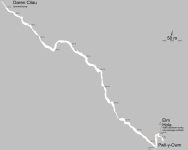I don't expect this to be an exhaustive guide on Therion and diving and I'm not even the most experienced on this forum. As there is very little online about Therion for divers, I thought I would put together all the stuff I struggled to figure out in one place.
Data
The .th file is the fundamental difference when using Therion for diving. Most of us now just generate the .th file using one of the many apps and don't really need to pay too much attention to it. With diving, we are almost always going to have to write it ourselves. Here is an example .th file ill step through the differences between a normal dry surveying .th file and a diving one.
The first change from normal dry data is the calibration.
This is done so you can enter depths as positive numbers as shown on your depth gauge and how you have probably written them in your notes.
Next, you need to add depth to the units and specify meters or feet. The compass will be the same as normal unless you're using something very odd.
"diving" needs to be set in the data line instead of "normal". You also get a choice here to enter your depths as either fromdepth and todepth or depthchange. I prefer depthchange due to how I pre-process my data. If you have taken LRUD with a pinger or measuring tape, you also need the left right up down columns. If you don't have LRUD data delete these or Therion will throw an error.
If you want more information on data Therion takes its format from Survex which is documented here.
Data
The .th file is the fundamental difference when using Therion for diving. Most of us now just generate the .th file using one of the many apps and don't really need to pay too much attention to it. With diving, we are almost always going to have to write it ourselves. Here is an example .th file ill step through the differences between a normal dry surveying .th file and a diving one.
survey sump_1 -title "Sump 1"
centerline
team "An Ero"
team "B Odgit "
date 2022.8.26
calibrate depth 0 -1
units length depth meters
units compass degrees
data diving from to length compass depthchange left right up down
extend left
0 1 6 152 0 0.5 10 15 4
1 2 3 120 0 0 10 15 4
2 3 3 120 0 0 2.8 5 2.1
3 4 3.3 88 2.3 2.2 2.3 5.4 0.6
4 5 3 74 0.3 3.8 2.1 2.7 0
5 6 3 118 0.5 1.6 1.9 3.3 0
6 7 6 118 0.7 0.8 0.9 3.4 0
7 8 6 165 0.2 0 2 3.3 0.5
8 9 2 112 0.6 2.1 2 0 0
9 10 3 90 -1.4 2 4 0 1
10 11 3 110 -1.6 0 5 0 0
11 12 6 140 -2.9 4 7 0 0
endcenterline
endsurvey
The first change from normal dry data is the calibration.
calibrate depth 0 -1
This is done so you can enter depths as positive numbers as shown on your depth gauge and how you have probably written them in your notes.
Next, you need to add depth to the units and specify meters or feet. The compass will be the same as normal unless you're using something very odd.
units length depth meters
units compass degrees
"diving" needs to be set in the data line instead of "normal". You also get a choice here to enter your depths as either fromdepth and todepth or depthchange. I prefer depthchange due to how I pre-process my data. If you have taken LRUD with a pinger or measuring tape, you also need the left right up down columns. If you don't have LRUD data delete these or Therion will throw an error.
data diving from to length compass depthchange left right up down
If you want more information on data Therion takes its format from Survex which is documented here.



